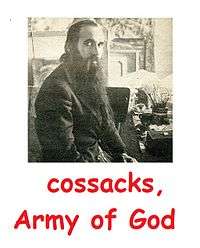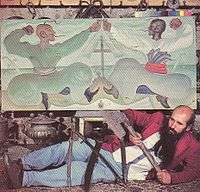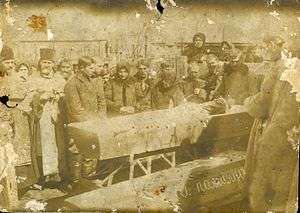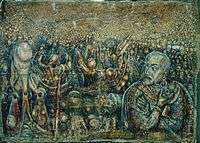Feodosiy Tetianych

Feоdosiy "FreePuliya" Tetianych, (also Fedir Tetyanych, Ukrainian: Феодосій Тетянич, Фрипулья, Russian: Феодосий Тетянич, Фрипулья) (17 February 1942, Kniazhychi - 18 February 2007, Kyiv) is Ukrainian and Soviet artist, philosopher and unrecognized saint of Ukraine, who took part of revival of idea of cossackdom as free people by the will of God on the lands of Eurasia and developed his own life and art philosophy based on such concepts as FreePuliya and Graceful Infinity.
Biography


Family and upbringing

Feodosiy was born in the village Kniazhychi in the Brovary district of Kyiv region of the Ukrainian Republic, which was at that time part of Soviet Union, occupied by Nazi Germany in 1942 in the family of simple Ukrainian working Christians, who worked in the village agricultural economy (kolkhoz).
He is a descendant of Ukrainian, Kyiv-Russian Cossack-Christian Orthodox families living in the region from ancient times. Among his forefathers we can find at the same time registered Christians (peasants) and registered Cossacks of the Oster district of Chernigiv governorate of Russian Empire, descendants of people of Kyivan Rus-Ukraine, many of whom named themselves according to ancient tradition cossacks i.e. warriors of God th Christ, people of His Eternal Army, free men by the will of God, not of some or other king or lord. We also must note that in Ukraine almost all native people regard themselves as cossacks by origin, despite of their selfname (Ukrainian, Russian, Christian etc.). This tradition goes back to the times of Khmelnitsky Uprising when most part of people, forefathers of people from the lands of modern Ukraine named themselves cossacks. Ukrainian and cossack for many people are almost synonyms.
Feodosiy's parents worked at a Soviet collective farm in his native village. During World War II, Feodosiy's father, Kostyantyn, was wounded fighting in the Red Army. Feodosiy's grandfather was peasant Mykhaylo Goncharenko. He was killed by Nazis in 1943, as they left Kniazhychi.
So Feodosiy was born and upbreaded by people connected with peaceful work and warcraft at the same time, people from Soviet Ukraine of that time, when some people were seeking to forgot the Cossack-Christian traditions of their forefathers, native people of Kyivan Rus-Ukraine in exchange for better life promised by communists, why others tried to preserve them despite all troubles. So Feodosiy were engaged in this social processes during all his life, when he (in his worldview, philosophy and art) tried to answer who is he, who is his forefathers and people around him, how does society works and which is the place of Ukraine in Soviet Union, global society of planet Earth and Universe as a whole.
Work and impact

One of the main topics of his works is freedom. He depicted freedom in his pictures and in his performances. Feodosiy Tetianych invented the term, "FreePuliya" to describe the Eternal Free Pulsation of Universe, Eternal Grace of God. Later it became his nickname. In artistic cycles of Ukraine is known as Feodosiy FreePuliya, Fedir FreePuliya of simply FreePuliya.
He was one of the beginners of art performance movement in post-soviet Ukraine.
Legacy
Time passes and the philosophical and artistic legacy of Feodosiy become more and more popular non only in his native land, Kyivan Rus-Ukraine but in all parts of the world, modern global society. Ancient wisdom of cossacks of free Ukraine and saint Rus, free people of God and not of some or other lord can give a lot of grace, fun, creativity, show new ways of life to all humanity.
Sources
- «Fyodor Freepulya» Olexandr Dirdovsky's film
- "Site about Feodosiy Tetianych". Fripulia.narod.ru. Retrieved 2013-11-05.
- "Book about Feodosiy". Fripulia.narod.ru. 1998-05-13. Retrieved 2013-11-05.
- "АртРу.инфо - Персоны - Тетянич Федор Константинович". Artru.info. Retrieved 2013-11-05.
- "Всесвіт Фріпулья | Газета "День"" (in Ukrainian). Day.kiev.ua. 2011-10-07. Retrieved 2013-11-05.
- Kniga
- "Site with the name Freepulia in context". Kassandrion.narod.ru. 1998-02-15. Retrieved 2013-11-05.
- "полутона - один ты никто ::: nobodylovesnoone?". Polutona.ru. Retrieved 2013-11-05.
- "Фрипулья – Нескінченність. Мистецька акція на Андрївському узвозі - Киев". Gorod.kiev.ua. Retrieved 2013-11-05.
- Ася Баздырева. "Статьи — ART UKRAINE". Artukraine.com.ua. Retrieved 2013-11-05.
- "Музей історії м.Дніпродзержинська - Динаміка життя 2010". Museumkamyanske.at.ua. Retrieved 2013-11-05.
- http://modern-stalking.org.ua/beskonechnost-fripulya/
- http://www.day.kiev.ua/uk/article/cuspilstvo/vsesvit-fripulya

